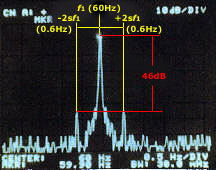Sea Water Injection Pump on an Offshore Oil Production Platform
In this case history the current spectrum of a motor when in a healthy state is compared to the spectrum after a stall and 'direct-on-line' starts.
3-phase, star connected, SCIM,
6600 V, 60 Hz, 3.6 MW/4825 h.p.,
376 Amp, 3580 r.p.m
Copper fabricated rotor,
Single Cage, 46 rotor Bars,
Nose Joint rotor design of Bars to End-Ring,
Low full-load slip (0.0055, or 0.55%)

Figure b-1
Original Current Spectrum from healthy unit

Figure b-2
Current Spectrum - high number of broken bars
MCSA FFT Current Spectrum
Dynamic Range = 80 dB
Frequency Resolution = 15 milliHertz/line
Test
Results
Figure b-1 is a current spectrum from a routine survey using MCSA.
The motor was operating at full-load current.
The predicted
twice slip frequency sidebands for a nameplate frequency of 60 Hz and
a full-load speed of 3580 r.p.m. was ±0.66 Hz.
Examination of the spectrum shows that there are sidebands at ±0.6
Hz around f1,
the supply frequency, which was at 59.99 Hz and not 60 Hz.
The measured frequency of the sidebands therefore correspond to within
less than 10% of the predicted values using full-load nameplate data.
The sidebands
are greater than 45 dB down on the supply current.
This corresponds to a perfectly healthy working unit for a 2-pole SCIM
with 46 rotor bars.
The ±2sf
1
Sidebands are 46dB down on f1,
in Figure b-1Sidebands are due to inherent rotor assymmetry caused by differences in Bar to End-Ring joints.
